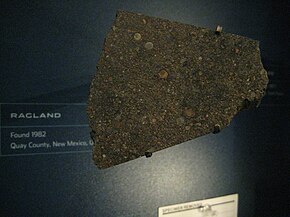| LL chondrite | |
|---|---|
| — Group — | |
 Ragland meteorite, an LL3.4 | |
| Type | Chondrite |
| Structural classification | ? |
| Class | Ordinary chondrite |
| Subgroups |
|
| Parent body | Unknown |
| Composition | Iron 19–22% (metallic iron (Fe) 0.3–3%, iron oxide (FeO) the rest), olivine(characteristic fayalite (Fa) 26 to 32 mol%), hypersthene (a pyroxene), Fe–Ni, troilite (FeS), feldspar or feldspathic glass, chromite, phosphates. |
| Petrologic type | Mostly 5 & 6 |
| Alternative names | LL chondrites, LL chondrite meteorites, Amphoterites |
The LL chondrites are a group of stony meteorites, the least abundant group of the ordinary chondrites, accounting for about 10–11% of observed ordinary-chondrite falls and 8–9% of all meteorite falls (see meteorite fall statistics). The ordinary chondrites are thought to have originated from three parent asteroids, with the fragments making up the H chondrite, L chondrite and LL chondrite groups respectively.[1] The composition of the Chelyabinsk meteorite is that of a LL chondrite meteorite. The material makeup of Itokawa, the asteroid visited by the Hayabusa spacecraft which landed on it and brought particles back to Earth also proved to be type LL chondrite.